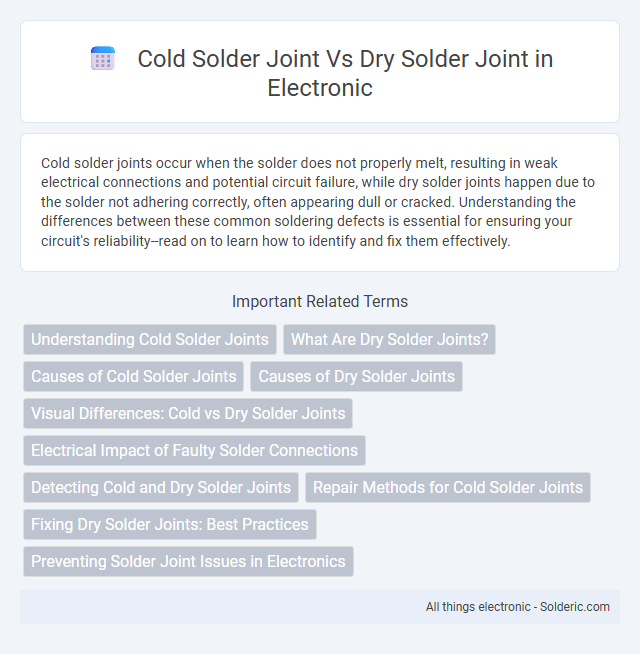Cold solder joints occur when the solder does not properly melt, resulting in weak electrical connections and potential circuit failure, while dry solder joints happen due to the solder not adhering correctly, often appearing dull or cracked. Understanding the differences between these common soldering defects is essential for ensuring your circuit's reliability--read on to learn how to identify and fix them effectively.
Comparison Table
| Aspect | Cold Solder Joint | Dry Solder Joint |
|---|---|---|
| Definition | Improper solder joint caused by insufficient heating, creating a weak bond. | Solder joint lacking adequate solder, leading to incomplete electrical connection. |
| Appearance | Dull, grainy, rough surface with visible cracks. | Thin, incomplete solder coverage with exposed pad or component lead. |
| Causes | Inadequate heating or movement during cooling. | Insufficient solder applied to the joint. |
| Electrical Characteristics | High resistance, intermittent connections, possible open circuit. | Partial or weak connection, increased resistance. |
| Reliability | Low reliability; prone to failure under mechanical stress or thermal cycling. | Low reliability; poor mechanical and electrical strength. |
| Detection | Visual inspection (dullness, cracks), testing with continuity meter. | Visual inspection (insufficient solder), electrical testing. |
| Correction | Reheat joint to proper temperature and ensure stable cooling. | Apply adequate solder to fully cover joint. |
Understanding Cold Solder Joints
Cold solder joints occur when solder fails to melt properly, resulting in weak electrical connections with high resistance, often caused by insufficient heat during the soldering process. Dry solder joints appear dull and grainy, indicating a poor bond between components and the PCB, which can lead to intermittent circuit failures. Identifying cold solder joints through visual inspection and testing helps ensure reliable electronic assemblies and prevents long-term device malfunctions.
What Are Dry Solder Joints?
Dry solder joints occur when the solder fails to properly wet the metal surfaces, resulting in a weak, brittle connection prone to electrical failure. These joints often appear dull, cracked, or grainy, contrasting with the shiny, smooth finish of a good solder joint. Understanding what dry solder joints are helps you diagnose and prevent poor electrical conductivity in your electronic repairs.
Causes of Cold Solder Joints
Cold solder joints occur when the solder fails to melt properly due to insufficient heat, often caused by using a low-temperature soldering iron or inadequate contact time. Poor surface preparation, such as dirty or oxidized components, further contributes to cold solder joints by preventing proper bonding. Your electronic connections may become unreliable if heat is inconsistent or rushed during the soldering process.
Causes of Dry Solder Joints
Dry solder joints are primarily caused by insufficient heat application during the soldering process, preventing proper melting and bonding of the solder to the metal surfaces. Contaminated or oxidized surfaces can also lead to poor adhesion, resulting in weak, unreliable joints. Inadequate flux usage and quick cooling further contribute to the formation of dry solder joints, compromising the electrical connection and mechanical stability.
Visual Differences: Cold vs Dry Solder Joints
Cold solder joints typically appear dull, grainy, and irregular with visible cracks or gaps, indicating poor metal fusion. Dry solder joints often show a rough, uneven surface but may have a slightly shinier finish than cold joints due to incomplete solder melting. Both defects compromise electrical conductivity, but visual inspection reveals cold joints as more matte and brittle while dry joints maintain some solder flow irregularities.
Electrical Impact of Faulty Solder Connections
Cold solder joints cause high electrical resistance and intermittent connectivity, leading to unreliable circuit performance and potential signal loss. Dry solder joints often result in weak mechanical bonds, increasing the risk of open circuits and sudden device failure. Your electronic device's functionality can be severely compromised by these faulty solder connections, necessitating careful inspection and repair.
Detecting Cold and Dry Solder Joints
Detecting cold and dry solder joints involves identifying irregularities such as dull, grainy surfaces or visible cracks and gaps around the soldered connection. Cold joints often exhibit poor wetting and may appear rough or lumpy, while dry joints typically show incomplete bonding and may have a matte finish or discoloration. Techniques such as magnified visual inspection, continuity testing with a multimeter, and thermal imaging can effectively reveal these soldering defects that compromise electrical connectivity and mechanical strength.
Repair Methods for Cold Solder Joints
Repairing cold solder joints involves reheating the joint with a soldering iron until the solder flows smoothly, ensuring a strong electrical connection. Applying flux before reheating removes oxidation and improves solder adhesion, while adding fresh solder can fill gaps and enhance joint integrity. Careful inspection and testing after repair confirm proper electrical continuity and mechanical stability.
Fixing Dry Solder Joints: Best Practices
Fixing dry solder joints requires thorough cleaning of the affected area to remove oxidation and contaminants before reheating with a properly calibrated soldering iron. Use flux liberally to improve solder flow and ensure strong metallurgical bonding, and apply fresh solder to restore a solid electrical connection. Inspect the joint visually and with a continuity tester to confirm the repair's effectiveness and prevent intermittent failures.
Preventing Solder Joint Issues in Electronics
Preventing solder joint issues in electronics requires understanding the differences between cold solder joints and dry solder joints, as both compromise electrical connections. Cold solder joints occur from insufficient heat during soldering, leading to weak mechanical bonds and increased resistance, while dry solder joints result from solder that has cooled too quickly or was disturbed before solidifying, causing brittle and cracked connections. To ensure your electronic devices function reliably, maintain proper soldering temperature, use the right soldering technique, and allow sufficient time for the joint to cool undisturbed.
cold solder joint vs dry solder joint Infographic

 solderic.com
solderic.com